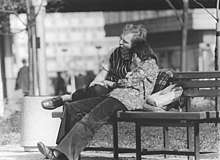Boyfriend
A boyfriend is a male friend or acquaintance, often specifying a regular male companion with whom one is platonic, romantically or sexually involved.[1] This is normally a short-term committed relationship, where other titles (e.g., husband, partner) are more commonly used for long-term committed relationships. A boyfriend can also be called an admirer, beau, suitor and sweetheart.[2] The analogous female term is "girlfriend".
Relationships (Outline) |
|---|
|
Endings |
Scope


Partners in committed non-marital relationships are also sometimes described as a significant other or partner,[3] especially if the individuals are cohabiting.
Boyfriend and partner mean different things to different people; the distinctions between the terms are subjective. How the term is used will ultimately be determined by personal preference.[4]
A 2005 study of 115 people ages 21 to 35 who were either living with or had lived with a romantic partner notes that the lack of proper terms often leads to awkward situations, such as someone upset over not being introduced in social situations to avoid the question.[5]
There is a significant difference between girlfriend and boyfriend, and girl friend and boy friend. In a strictly grammatical sense, a girlfriend [6] or boyfriend [7] is an 'individual of significance' with whom one shares a relationship.
Word history
The word dating entered the American language during the Roaring Twenties. Prior to that, courtship was a matter of family and community interest. Starting around the time of the American Civil War, courtship became a private matter for couples.[8] In the early to mid 20th century in the US, women were often visited by "gentleman callers", single men who would arrive at the home of a young woman with the hopes of beginning a courtship.[9] The era of the gentleman caller ended in the early 20th century and the modern idea of dating developed.[8]
In literature, the term is discussed in July 1988 in Neil Bartlett's, Who Was That Man? A Present for Mr Oscar Wilde. On pages 108–110, Bartlett quotes from an issue of The Artist and Journal of Home Culture, which refers to Alectryon as "a boyfriend of Mars".
Synonyms
- An older man may be referred to as a sugar daddy, a well-to-do man who financially supports or lavishly spends on a mistress, girlfriend, or boyfriend.[10]
- In popular culture, slang, internet chat, and cellphone texting, the truncated acronym bf is also used.[11]
- Leman, an archaic word for "sweetheart, paramour," from Medieval British leofman (c.1205), from Old English leof (cognate of Dutch lief, German lieb) "dear" + man "human being, person" was originally applied to either gender, but usually means mistress.[12]
- The term young man was at some periods used with a similar connotation. For example, in the 1945 film "My Name Is Julia Ross" the female protagonist, seeking a secretarial job, is asked if she has "a young man"[13] – where in later films a similar question would have referred to "a boyfriend".
See also
References
- Compact Oxford English Dictionary of Current English , published 23 June 2005, University of Oxford, ISBN 978-0-19-861022-9 edition
- Thesaurus.com. "Boyfriend". Retrieved 6 May 2012.
- Thesaurus.com. "Significant other". Retrieved 6 May 2012.
- Goldstein, Meredith (15 June 2009). "Partner? Boyfriernd? Maybe?". The Boston Globe. Retrieved 6 May 2012.
- Jayson, Sharon (23 June 2008). "Adults stumble over what to call their romantic partners". USA Today. Retrieved 6 May 2012.
- "Girlfriend". WordNet. Retrieved 11 November 2010.
- "Boyfriend". WordNet. Retrieved 11 November 2010.
- Hirsch, Elaine. "The History of Dating and Communication". Retrieved 6 May 2012.
- Hunt, Lana J. "Ladies and Gentleman". Archived from the original on 28 July 2012. Retrieved 6 May 2012.
- Merriam-Webster. "Sugar daddy". Retrieved 6 May 2012.
- BF – Definition by AcronymFinder
- The Free Dictionary By Farlex. "Leman". Retrieved 6 May 2012.
- Aliperti, Cliff. "My Name is Julia Ross (1945) starring Nina Foch and George Macready". Retrieved 6 May 2012.